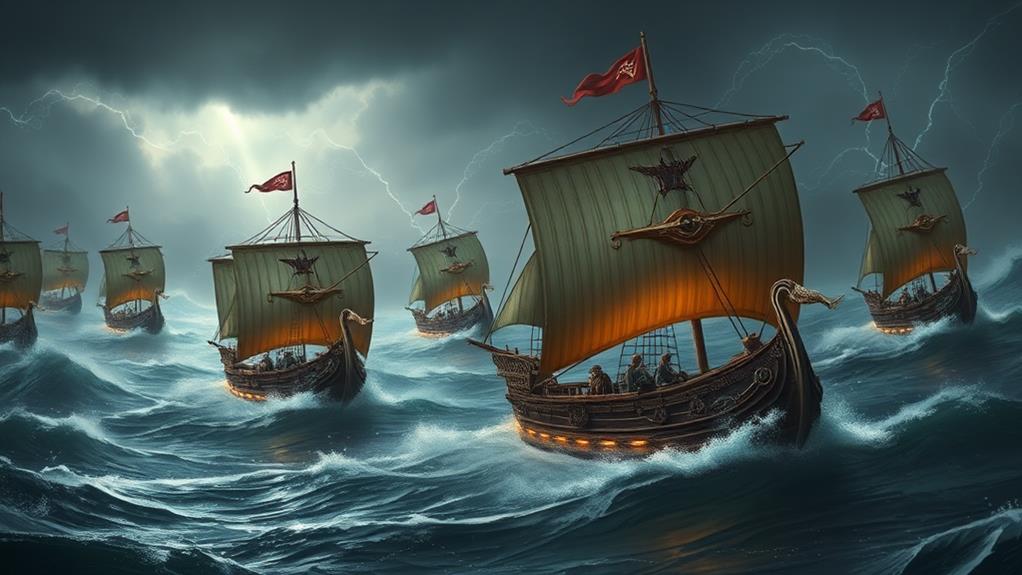
Naval tactics in Middle Earth were diverse and decisive. You'd see swift, agile Elven ships using hit-and-run tactics against Morgoth's forces, while the mighty Númenórean fleets showcased unmatched speed and durability. The Corsairs of Umbar favored guerrilla raids, harassing Gondor's coast with black-sailed ships. Coastal defenses employed elevated archers, underwater spikes, and trebuchets. Strategic waterways, like the Anduin River, were pivotal for commerce and military logistics. Legendary commanders such as Eärendil, Círdan, and Thorongil shaped the naval landscape with their strategic brilliance. There's a lot more to discover about Middle Earth's naval warfare and its intricate strategies.
Historical Naval Conflicts
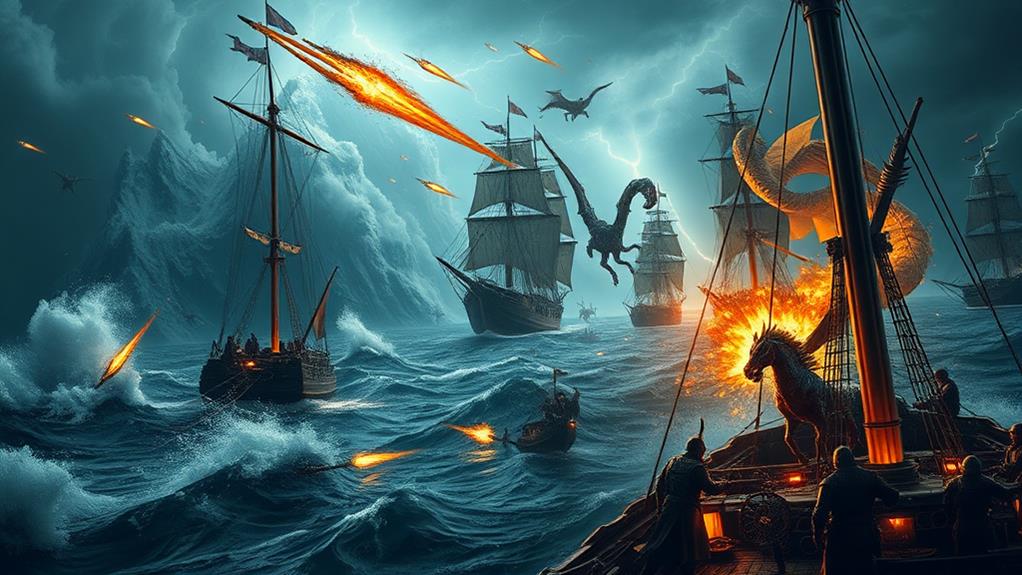
When examining historical naval conflicts in Middle Earth, you'll find a rich tapestry of maritime strategy and warfare. From the turbulent seas of Beleriand to the expansive waters around Númenor, each conflict paints a vivid picture of the naval prowess and ingenuity of Middle Earth's inhabitants.
One significant conflict is the Battle of the Lammoth, where the Elves of the Falas clashed with Morgoth's forces. Using swift, mobile ships, the Elves employed hit-and-run tactics to disrupt enemy supply lines. Their mastery of the seas was vital in delaying Morgoth's advances.
Another notable conflict is the Downfall of Númenor. This catastrophic event wasn't just a tragic tale but also a dramatic naval disaster. The Númenóreans, proud seafarers, attempted to invade the Undying Lands. Their fleet, unparalleled in size and strength, was swallowed by the sea as divine retribution.
Lastly, the Corsairs of Umbar's raids during the Third Age showcased guerrilla naval tactics. They harried Gondor's coastlines, utilizing swift, agile ships to outrun and outmaneuver their enemies.
These historical conflicts underline the strategic importance of naval power in Middle Earth, shaping the destinies of its peoples.
Key Naval Forces
The historical naval conflicts of Middle Earth set the stage for understanding the key naval forces that dominated its waters. You'll find that each major power had its own unique strengths and strategies, shaping the course of maritime warfare.
- Númenóreans: Masters of the sea, their ships were unmatched in speed and durability. Númenor's sailors were skilled and disciplined, making them a formidable force.
- Corsairs of Umbar: Ruthless and cunning, the Corsairs terrorized coastlines with swift, surprise attacks. Their black-sailed ships were a symbol of fear.
- Elves of Lindon: With their elegant, swift vessels, the Elves of Lindon brought an element of grace and precision to naval battles. Their ships were often enchanted, blending beauty with lethality.
- Gondorians: The naval arm of Gondor was powerful and structured. Their well-organized fleets patrolled the seas, ensuring the safety of their coastal cities.
- Haradrim: Known for their large, imposing ships, the Haradrim used brute strength and numbers to overwhelm their enemies. Their vessels were often adorned with fearsome decorations to intimidate foes.
Ship Types and Designs
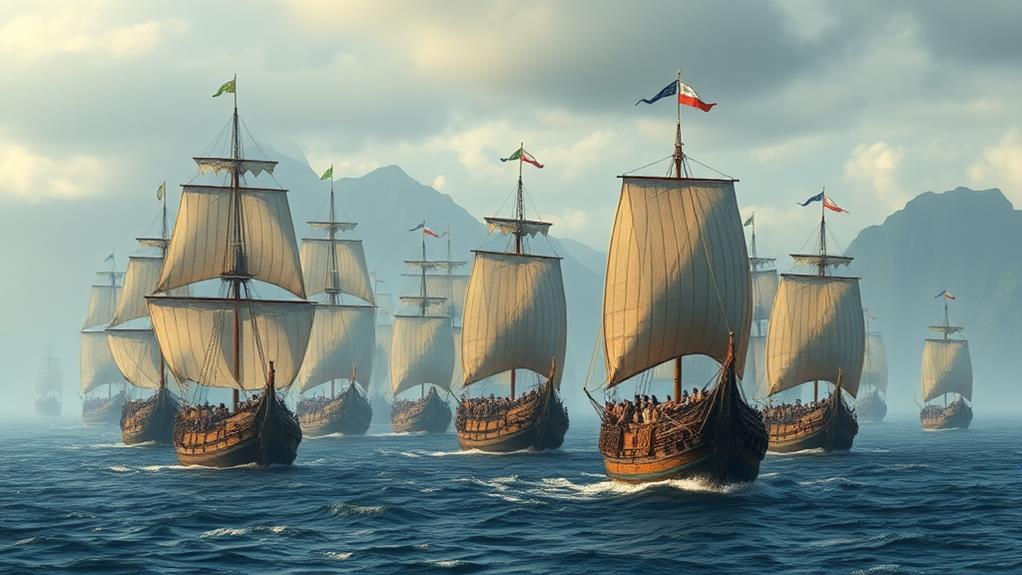
Understanding the various ship types and designs in Middle Earth is essential to grasping the intricacies of its naval warfare. Different factions relied on unique vessels tailored to their strategic needs. The Elves, for instance, favored elegant, swift ships like the Swan-ships of the Grey Havens. These vessels, with their sleek designs and lightweight construction, allowed for rapid movement across the seas, making them ideal for quick strikes and reconnaissance.
On the other hand, Men of Gondor utilized sturdier ships known as dromonds. These warships were heavily fortified, with reinforced hulls and multiple decks, capable of carrying large numbers of troops and artillery. Their design prioritized durability and firepower, making them formidable opponents in prolonged engagements.
The Corsairs of Umbar, notorious for their piracy, employed black ships. These vessels combined speed with a menacing appearance, often featuring sharp prows for ramming and ample space for plunder. Their agility made them perfect for hit-and-run tactics, striking fear into coastal settlements.
Lastly, the Dwarves had their stone-laden barges, robust and resilient, though slower. These ships were built to withstand harsh conditions and transport heavy cargo, reflecting the Dwarves' emphasis on endurance and resourcefulness. Each vessel's design reflects its creators' strengths and strategic priorities.
Battle Formations
In naval warfare across Middle Earth, battle formations played a pivotal role in determining the outcome of maritime conflicts. Each commander had to choose a formation that maximized their fleet's strengths while exploiting the enemy's weaknesses. You'd often see fleets arranged meticulously, designed for both offense and defense.
Consider these vivid formations:
- Line Abreast: Ships aligned side by side, maximizing broadside firepower.
- Column Formation: Vessels followed each other in a single line, ideal for traversing narrow straits.
- V-Formation: Ships forming a "V" shape, perfect for encircling the enemy or breaking through blockades.
- Echelon Formation: Staggered arrangement, enhancing visibility and reducing vulnerability to enemy fire.
- Circle Formation: Defensive ring, protecting weaker vessels or valuable cargo within the center.
Imagine your fleet in a Line Abreast formation, releasing a devastating volley of arrows and catapult stones. Or picture the chaos as your enemy's ships struggle against your V-Formation, unable to escape the encirclement. Mastering these formations was vital for any commander aiming for victory on Middle Earth's treacherous seas. Each choice you made could spell triumph or disaster, depending on the tactical situation and the nature of your adversary.
Coastal Defense Tactics
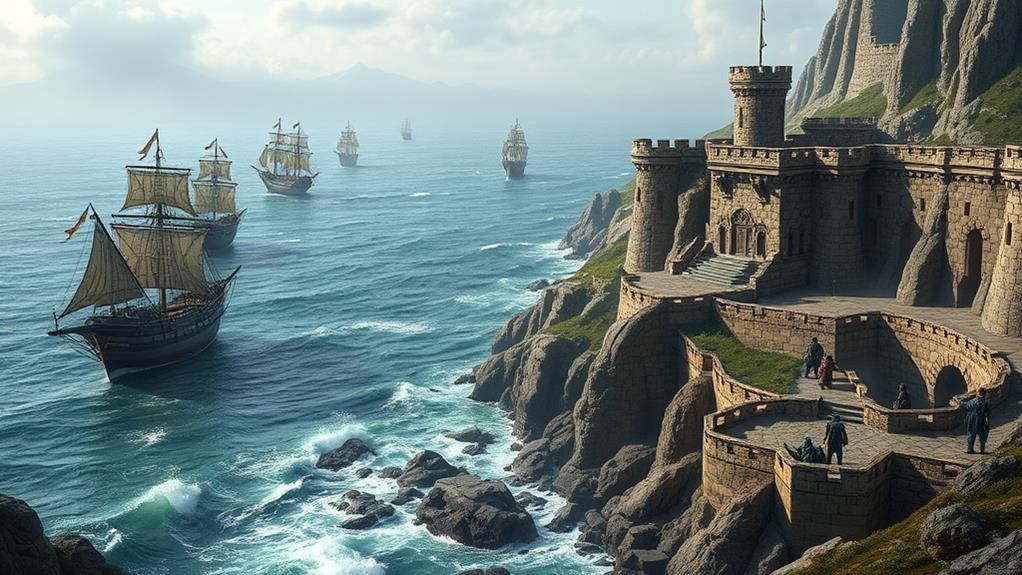
When you're facing an enemy at sea, a well-planned coastal defense can be your strongest ally. By fortifying your shores, you can turn the tides of battle even before the enemy makes landfall. Coastal defenses involve a blend of physical barriers, strategic positioning, and surprise tactics, ensuring you catch your foes off guard.
First, consider the natural landscape. Use cliffs, reefs, and narrow inlets to your advantage. Place archers and trebuchets on elevated positions for maximum range and impact. Next, deploy traps and obstacles like caltrops and underwater spikes to slow the enemy's advance. Mines hidden just beneath the water's surface can cripple invading ships before they reach your shores.
Here's a quick reference table for effective coastal defense elements:
| Element | Purpose | Deployment Area |
|---|---|---|
| Elevated Archers | Long-range attack | Cliffs, Towers |
| Trebuchets | Heavy bombardment | Elevated Grounds |
| Caltrops | Slow enemy advance | Beachfront |
| Underwater Spikes | Damage ships' hulls | Shallow Waters |
| Mines | Cripple invading ships | Just below surface |
Strategic Waterways
While robust coastal defenses can thwart an enemy's initial approach, controlling strategic waterways is where true mastery of naval tactics shines. Waterways in Middle Earth, such as rivers, straits, and seas, serve as essential arteries for trade, troop movement, and communication. By dominating these routes, you can disrupt enemy supply lines, stage surprise attacks, and maintain the upper hand.
Imagine the following:
- The Anduin River: A sprawling waterway snaking through Gondor, serving as a lifeline for both commerce and military logistics.
- The Greyflood: A river marking the boundary between Eriador and Enedwaith, pivotal for controlling the region.
- The Sea of Rhûn: A vast inland sea, providing a strategic route for Easterling forces.
- The Mouths of Sirion: Coastal estuaries that are pivotal for launching naval expeditions.
- The Bay of Belfalas: A deep bay offering a natural harbor for fleets, making it a strategic stronghold.
Mastering these waterways allows you to anticipate enemy movements, cut off reinforcements, and guarantee your forces have the resources they need. By focusing on these critical points, you can effectively dictate the terms of engagement and secure victory in the complex naval theater of Middle Earth.
Famous Naval Commanders
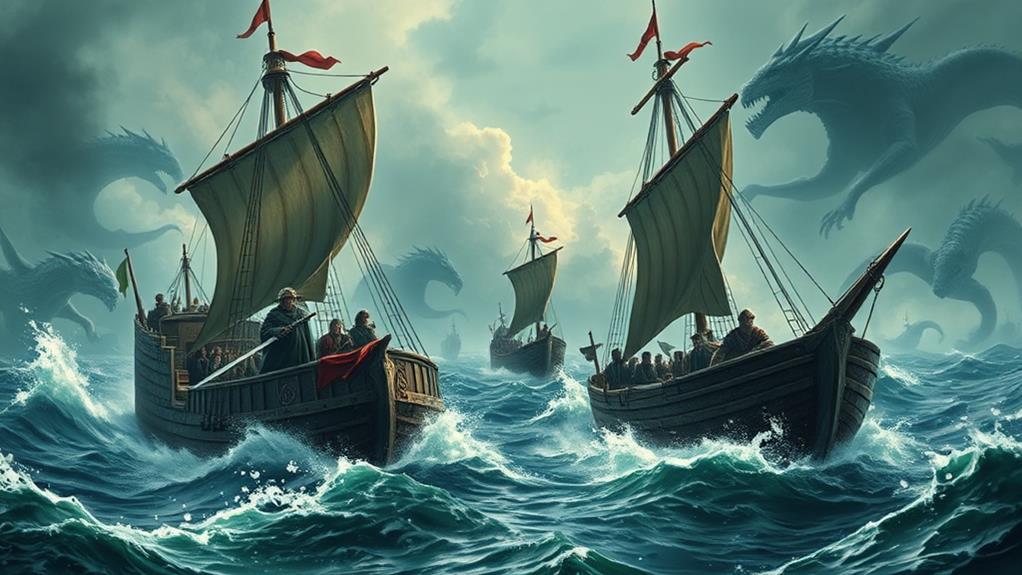
Among the notable figures who have shaped naval warfare in Middle Earth, a few commanders stand out for their exceptional strategy and leadership. You'll find their names etched in history for their daring maneuvers and brilliant tactics on the high seas.
One such commander is Eärendil the Mariner. With his ship Vingilot, he sailed through perilous waters, playing a vital role in the War of Wrath. His navigation skills were unmatched, and his bravery inspired many.
Another key figure is Círdan the Shipwright. Known for his wisdom and shipbuilding prowess, Círdan provided invaluable support during the battles against Sauron. His strategic deployment of fleets was a game-changer.
Lastly, don't forget Thorongil (an alias of Aragorn). His surprise attack on Umbar's Corsairs was legendary, crippling their fleet and securing vital victories for Gondor.
Here's a quick reference table of these commanders and their accomplishments:
| Commander | Notable Ship | Key Contribution |
|---|---|---|
| Eärendil | Vingilot | Role in the War of Wrath |
| Círdan | Falathrim | Strategic fleet deployments |
| Thorongil | Unspecified | Surprise attack on Umbar |
| Amandil | Unspecified | Attempt to seek Valar's aid |
| Aldarion | Númenórámar | Expansion of Númenorean navy |
These leaders exemplify the art of naval warfare in Middle Earth, showcasing courage, wisdom, and strategic brilliance.
At a Glance
In Middle-earth, mastering naval tactics is like traversing a tempestuous sea; it requires skill, courage, and a deep understanding of your enemy. You've explored the key naval forces, ship designs, and battle formations that shaped epic conflicts. Coastal defenses and strategic waterways proved vital, guided by legendary commanders. As you set sail from this exploration, remember: the tides of war can turn swiftly, and only the prepared will ride the waves to victory.






